Investigation: Ross River Fever's Impact in Queensland, Australia
VerifiedAdded on 2022/12/12
|7
|1891
|405
Report
AI Summary
This report provides a comprehensive analysis of Ross River Fever (RRV) and its impact on the Queensland population. It begins with an introduction to the disease, caused by a mosquito-borne virus, and its symptoms, including flu-like symptoms and polyarthritis. The methodology section outlines the qualitative and quantitative research methods used to gather data on the disease's factors and complications. Findings detail the factors associated with RRV, including its symptoms and the critical conditions it can cause. The study's location is specified, and the data analysis techniques used are described. Key risk factors, such as the incubation period and likely affected populations, are identified. The report also covers management strategies, comparison of two alphaviruses, challenges faced in controlling the virus, and proposed actions to improve risk management. The report concludes with an overview of the findings, referencing various books and journals to support the analysis.
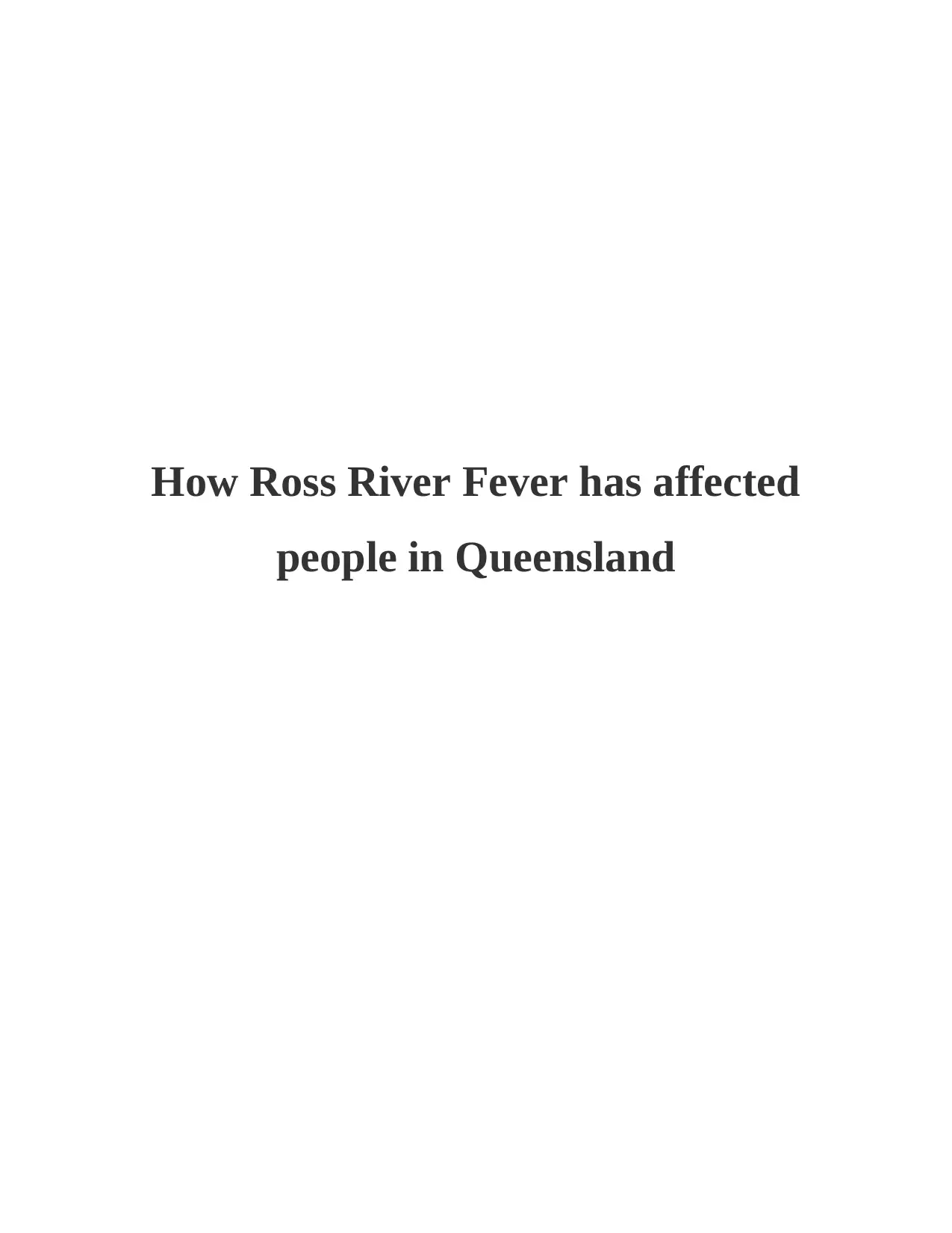
How Ross River Fever has affected
people in Queensland
people in Queensland
Paraphrase This Document
Need a fresh take? Get an instant paraphrase of this document with our AI Paraphraser

Table of Contents
INTRODUCTION...........................................................................................................................3
INTRODUCTION...........................................................................................................................3
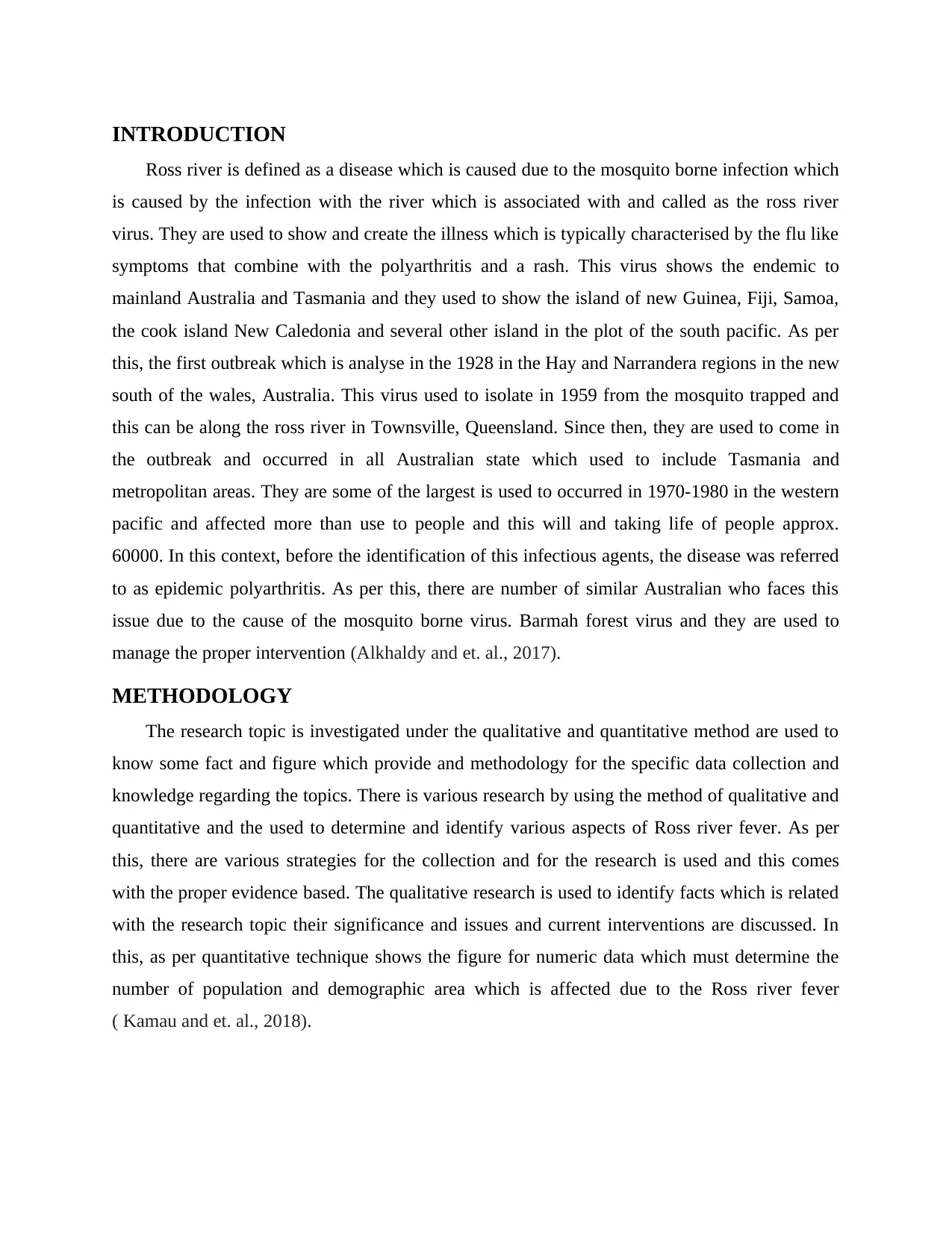
INTRODUCTION
Ross river is defined as a disease which is caused due to the mosquito borne infection which
is caused by the infection with the river which is associated with and called as the ross river
virus. They are used to show and create the illness which is typically characterised by the flu like
symptoms that combine with the polyarthritis and a rash. This virus shows the endemic to
mainland Australia and Tasmania and they used to show the island of new Guinea, Fiji, Samoa,
the cook island New Caledonia and several other island in the plot of the south pacific. As per
this, the first outbreak which is analyse in the 1928 in the Hay and Narrandera regions in the new
south of the wales, Australia. This virus used to isolate in 1959 from the mosquito trapped and
this can be along the ross river in Townsville, Queensland. Since then, they are used to come in
the outbreak and occurred in all Australian state which used to include Tasmania and
metropolitan areas. They are some of the largest is used to occurred in 1970-1980 in the western
pacific and affected more than use to people and this will and taking life of people approx.
60000. In this context, before the identification of this infectious agents, the disease was referred
to as epidemic polyarthritis. As per this, there are number of similar Australian who faces this
issue due to the cause of the mosquito borne virus. Barmah forest virus and they are used to
manage the proper intervention (Alkhaldy and et. al., 2017).
METHODOLOGY
The research topic is investigated under the qualitative and quantitative method are used to
know some fact and figure which provide and methodology for the specific data collection and
knowledge regarding the topics. There is various research by using the method of qualitative and
quantitative and the used to determine and identify various aspects of Ross river fever. As per
this, there are various strategies for the collection and for the research is used and this comes
with the proper evidence based. The qualitative research is used to identify facts which is related
with the research topic their significance and issues and current interventions are discussed. In
this, as per quantitative technique shows the figure for numeric data which must determine the
number of population and demographic area which is affected due to the Ross river fever
( Kamau and et. al., 2018).
Ross river is defined as a disease which is caused due to the mosquito borne infection which
is caused by the infection with the river which is associated with and called as the ross river
virus. They are used to show and create the illness which is typically characterised by the flu like
symptoms that combine with the polyarthritis and a rash. This virus shows the endemic to
mainland Australia and Tasmania and they used to show the island of new Guinea, Fiji, Samoa,
the cook island New Caledonia and several other island in the plot of the south pacific. As per
this, the first outbreak which is analyse in the 1928 in the Hay and Narrandera regions in the new
south of the wales, Australia. This virus used to isolate in 1959 from the mosquito trapped and
this can be along the ross river in Townsville, Queensland. Since then, they are used to come in
the outbreak and occurred in all Australian state which used to include Tasmania and
metropolitan areas. They are some of the largest is used to occurred in 1970-1980 in the western
pacific and affected more than use to people and this will and taking life of people approx.
60000. In this context, before the identification of this infectious agents, the disease was referred
to as epidemic polyarthritis. As per this, there are number of similar Australian who faces this
issue due to the cause of the mosquito borne virus. Barmah forest virus and they are used to
manage the proper intervention (Alkhaldy and et. al., 2017).
METHODOLOGY
The research topic is investigated under the qualitative and quantitative method are used to
know some fact and figure which provide and methodology for the specific data collection and
knowledge regarding the topics. There is various research by using the method of qualitative and
quantitative and the used to determine and identify various aspects of Ross river fever. As per
this, there are various strategies for the collection and for the research is used and this comes
with the proper evidence based. The qualitative research is used to identify facts which is related
with the research topic their significance and issues and current interventions are discussed. In
this, as per quantitative technique shows the figure for numeric data which must determine the
number of population and demographic area which is affected due to the Ross river fever
( Kamau and et. al., 2018).
⊘ This is a preview!⊘
Do you want full access?
Subscribe today to unlock all pages.

Trusted by 1+ million students worldwide
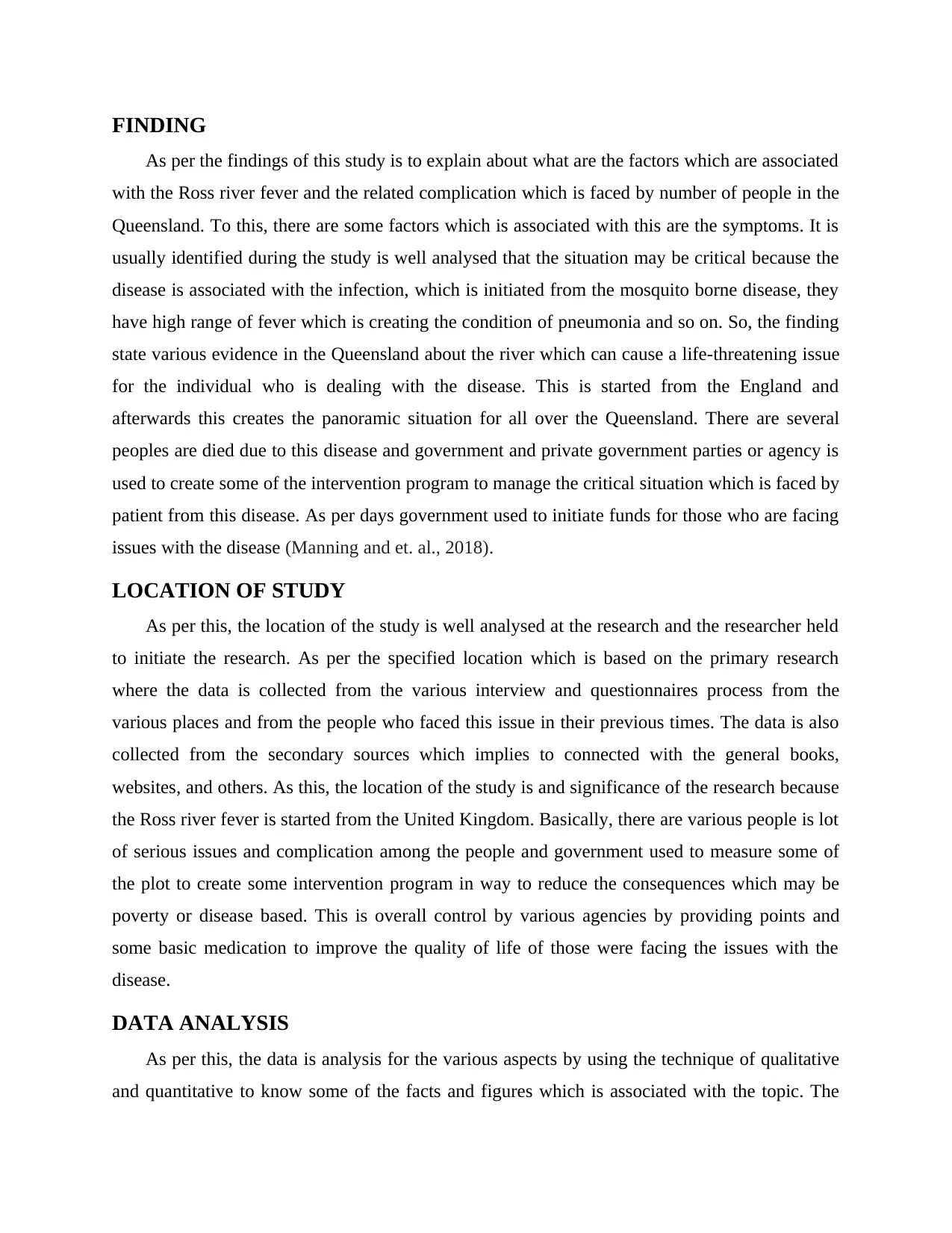
FINDING
As per the findings of this study is to explain about what are the factors which are associated
with the Ross river fever and the related complication which is faced by number of people in the
Queensland. To this, there are some factors which is associated with this are the symptoms. It is
usually identified during the study is well analysed that the situation may be critical because the
disease is associated with the infection, which is initiated from the mosquito borne disease, they
have high range of fever which is creating the condition of pneumonia and so on. So, the finding
state various evidence in the Queensland about the river which can cause a life-threatening issue
for the individual who is dealing with the disease. This is started from the England and
afterwards this creates the panoramic situation for all over the Queensland. There are several
peoples are died due to this disease and government and private government parties or agency is
used to create some of the intervention program to manage the critical situation which is faced by
patient from this disease. As per days government used to initiate funds for those who are facing
issues with the disease (Manning and et. al., 2018).
LOCATION OF STUDY
As per this, the location of the study is well analysed at the research and the researcher held
to initiate the research. As per the specified location which is based on the primary research
where the data is collected from the various interview and questionnaires process from the
various places and from the people who faced this issue in their previous times. The data is also
collected from the secondary sources which implies to connected with the general books,
websites, and others. As this, the location of the study is and significance of the research because
the Ross river fever is started from the United Kingdom. Basically, there are various people is lot
of serious issues and complication among the people and government used to measure some of
the plot to create some intervention program in way to reduce the consequences which may be
poverty or disease based. This is overall control by various agencies by providing points and
some basic medication to improve the quality of life of those were facing the issues with the
disease.
DATA ANALYSIS
As per this, the data is analysis for the various aspects by using the technique of qualitative
and quantitative to know some of the facts and figures which is associated with the topic. The
As per the findings of this study is to explain about what are the factors which are associated
with the Ross river fever and the related complication which is faced by number of people in the
Queensland. To this, there are some factors which is associated with this are the symptoms. It is
usually identified during the study is well analysed that the situation may be critical because the
disease is associated with the infection, which is initiated from the mosquito borne disease, they
have high range of fever which is creating the condition of pneumonia and so on. So, the finding
state various evidence in the Queensland about the river which can cause a life-threatening issue
for the individual who is dealing with the disease. This is started from the England and
afterwards this creates the panoramic situation for all over the Queensland. There are several
peoples are died due to this disease and government and private government parties or agency is
used to create some of the intervention program to manage the critical situation which is faced by
patient from this disease. As per days government used to initiate funds for those who are facing
issues with the disease (Manning and et. al., 2018).
LOCATION OF STUDY
As per this, the location of the study is well analysed at the research and the researcher held
to initiate the research. As per the specified location which is based on the primary research
where the data is collected from the various interview and questionnaires process from the
various places and from the people who faced this issue in their previous times. The data is also
collected from the secondary sources which implies to connected with the general books,
websites, and others. As this, the location of the study is and significance of the research because
the Ross river fever is started from the United Kingdom. Basically, there are various people is lot
of serious issues and complication among the people and government used to measure some of
the plot to create some intervention program in way to reduce the consequences which may be
poverty or disease based. This is overall control by various agencies by providing points and
some basic medication to improve the quality of life of those were facing the issues with the
disease.
DATA ANALYSIS
As per this, the data is analysis for the various aspects by using the technique of qualitative
and quantitative to know some of the facts and figures which is associated with the topic. The
Paraphrase This Document
Need a fresh take? Get an instant paraphrase of this document with our AI Paraphraser
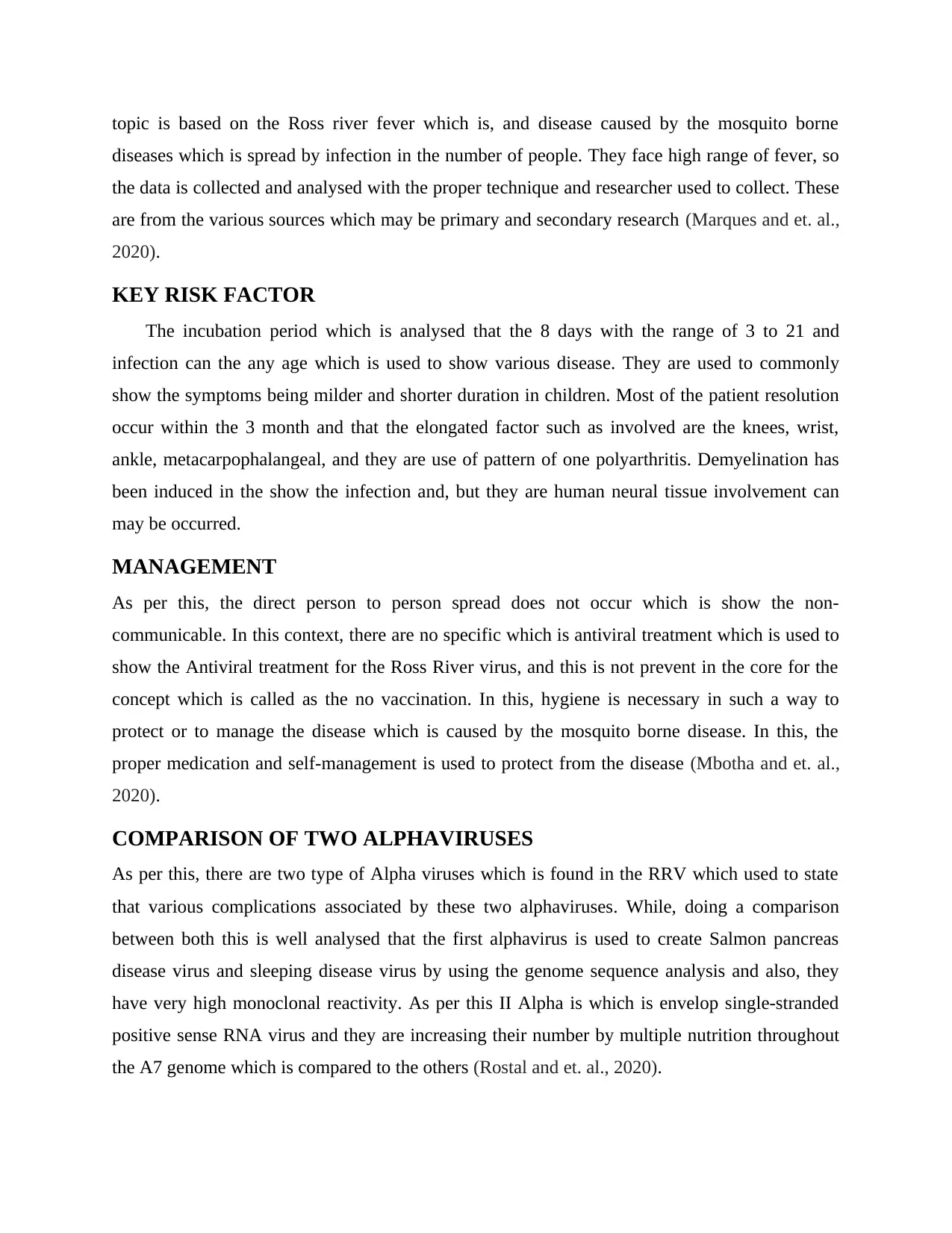
topic is based on the Ross river fever which is, and disease caused by the mosquito borne
diseases which is spread by infection in the number of people. They face high range of fever, so
the data is collected and analysed with the proper technique and researcher used to collect. These
are from the various sources which may be primary and secondary research (Marques and et. al.,
2020).
KEY RISK FACTOR
The incubation period which is analysed that the 8 days with the range of 3 to 21 and
infection can the any age which is used to show various disease. They are used to commonly
show the symptoms being milder and shorter duration in children. Most of the patient resolution
occur within the 3 month and that the elongated factor such as involved are the knees, wrist,
ankle, metacarpophalangeal, and they are use of pattern of one polyarthritis. Demyelination has
been induced in the show the infection and, but they are human neural tissue involvement can
may be occurred.
MANAGEMENT
As per this, the direct person to person spread does not occur which is show the non-
communicable. In this context, there are no specific which is antiviral treatment which is used to
show the Antiviral treatment for the Ross River virus, and this is not prevent in the core for the
concept which is called as the no vaccination. In this, hygiene is necessary in such a way to
protect or to manage the disease which is caused by the mosquito borne disease. In this, the
proper medication and self-management is used to protect from the disease (Mbotha and et. al.,
2020).
COMPARISON OF TWO ALPHAVIRUSES
As per this, there are two type of Alpha viruses which is found in the RRV which used to state
that various complications associated by these two alphaviruses. While, doing a comparison
between both this is well analysed that the first alphavirus is used to create Salmon pancreas
disease virus and sleeping disease virus by using the genome sequence analysis and also, they
have very high monoclonal reactivity. As per this II Alpha is which is envelop single-stranded
positive sense RNA virus and they are increasing their number by multiple nutrition throughout
the A7 genome which is compared to the others (Rostal and et. al., 2020).
diseases which is spread by infection in the number of people. They face high range of fever, so
the data is collected and analysed with the proper technique and researcher used to collect. These
are from the various sources which may be primary and secondary research (Marques and et. al.,
2020).
KEY RISK FACTOR
The incubation period which is analysed that the 8 days with the range of 3 to 21 and
infection can the any age which is used to show various disease. They are used to commonly
show the symptoms being milder and shorter duration in children. Most of the patient resolution
occur within the 3 month and that the elongated factor such as involved are the knees, wrist,
ankle, metacarpophalangeal, and they are use of pattern of one polyarthritis. Demyelination has
been induced in the show the infection and, but they are human neural tissue involvement can
may be occurred.
MANAGEMENT
As per this, the direct person to person spread does not occur which is show the non-
communicable. In this context, there are no specific which is antiviral treatment which is used to
show the Antiviral treatment for the Ross River virus, and this is not prevent in the core for the
concept which is called as the no vaccination. In this, hygiene is necessary in such a way to
protect or to manage the disease which is caused by the mosquito borne disease. In this, the
proper medication and self-management is used to protect from the disease (Mbotha and et. al.,
2020).
COMPARISON OF TWO ALPHAVIRUSES
As per this, there are two type of Alpha viruses which is found in the RRV which used to state
that various complications associated by these two alphaviruses. While, doing a comparison
between both this is well analysed that the first alphavirus is used to create Salmon pancreas
disease virus and sleeping disease virus by using the genome sequence analysis and also, they
have very high monoclonal reactivity. As per this II Alpha is which is envelop single-stranded
positive sense RNA virus and they are increasing their number by multiple nutrition throughout
the A7 genome which is compared to the others (Rostal and et. al., 2020).
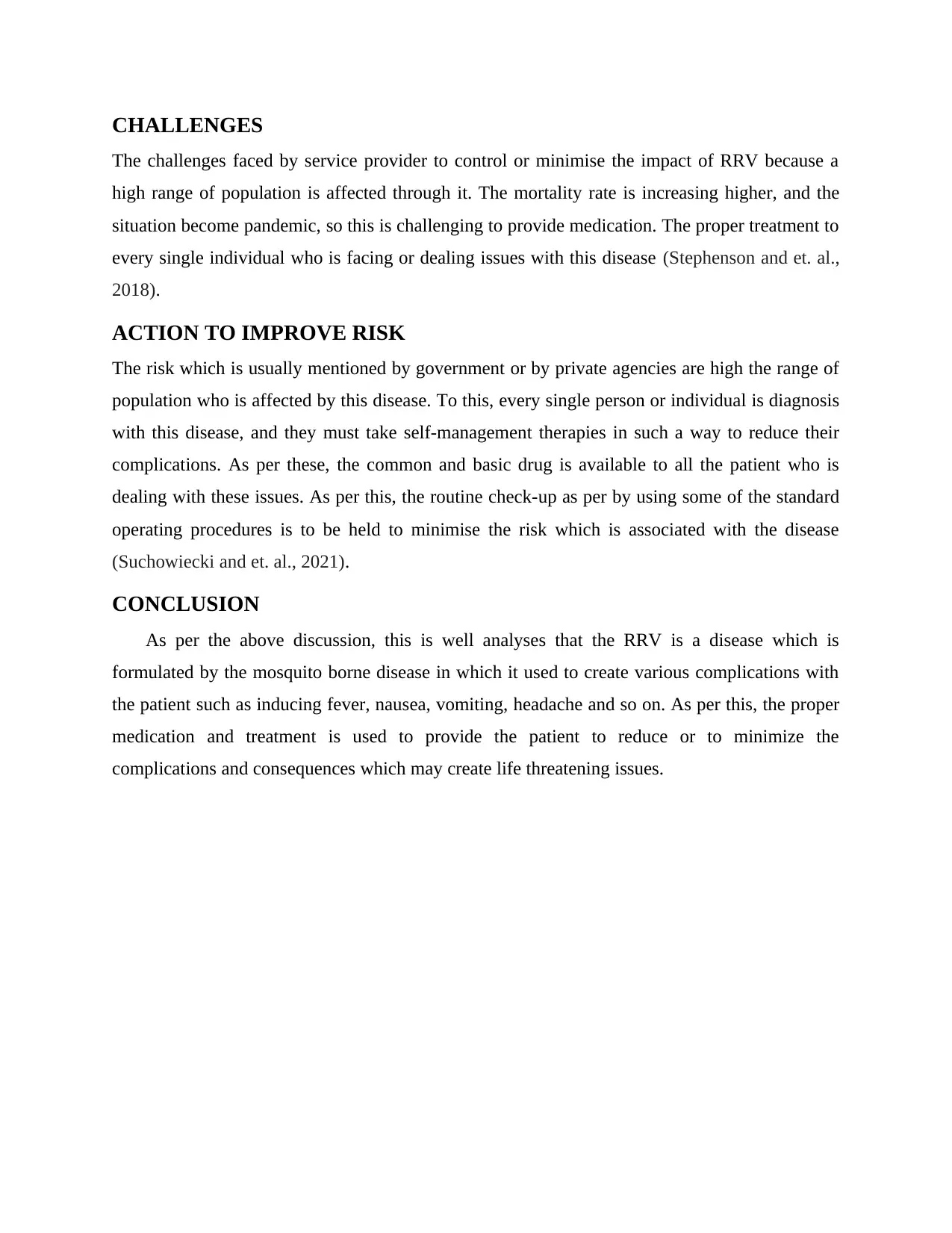
CHALLENGES
The challenges faced by service provider to control or minimise the impact of RRV because a
high range of population is affected through it. The mortality rate is increasing higher, and the
situation become pandemic, so this is challenging to provide medication. The proper treatment to
every single individual who is facing or dealing issues with this disease (Stephenson and et. al.,
2018).
ACTION TO IMPROVE RISK
The risk which is usually mentioned by government or by private agencies are high the range of
population who is affected by this disease. To this, every single person or individual is diagnosis
with this disease, and they must take self-management therapies in such a way to reduce their
complications. As per these, the common and basic drug is available to all the patient who is
dealing with these issues. As per this, the routine check-up as per by using some of the standard
operating procedures is to be held to minimise the risk which is associated with the disease
(Suchowiecki and et. al., 2021).
CONCLUSION
As per the above discussion, this is well analyses that the RRV is a disease which is
formulated by the mosquito borne disease in which it used to create various complications with
the patient such as inducing fever, nausea, vomiting, headache and so on. As per this, the proper
medication and treatment is used to provide the patient to reduce or to minimize the
complications and consequences which may create life threatening issues.
The challenges faced by service provider to control or minimise the impact of RRV because a
high range of population is affected through it. The mortality rate is increasing higher, and the
situation become pandemic, so this is challenging to provide medication. The proper treatment to
every single individual who is facing or dealing issues with this disease (Stephenson and et. al.,
2018).
ACTION TO IMPROVE RISK
The risk which is usually mentioned by government or by private agencies are high the range of
population who is affected by this disease. To this, every single person or individual is diagnosis
with this disease, and they must take self-management therapies in such a way to reduce their
complications. As per these, the common and basic drug is available to all the patient who is
dealing with these issues. As per this, the routine check-up as per by using some of the standard
operating procedures is to be held to minimise the risk which is associated with the disease
(Suchowiecki and et. al., 2021).
CONCLUSION
As per the above discussion, this is well analyses that the RRV is a disease which is
formulated by the mosquito borne disease in which it used to create various complications with
the patient such as inducing fever, nausea, vomiting, headache and so on. As per this, the proper
medication and treatment is used to provide the patient to reduce or to minimize the
complications and consequences which may create life threatening issues.
⊘ This is a preview!⊘
Do you want full access?
Subscribe today to unlock all pages.

Trusted by 1+ million students worldwide
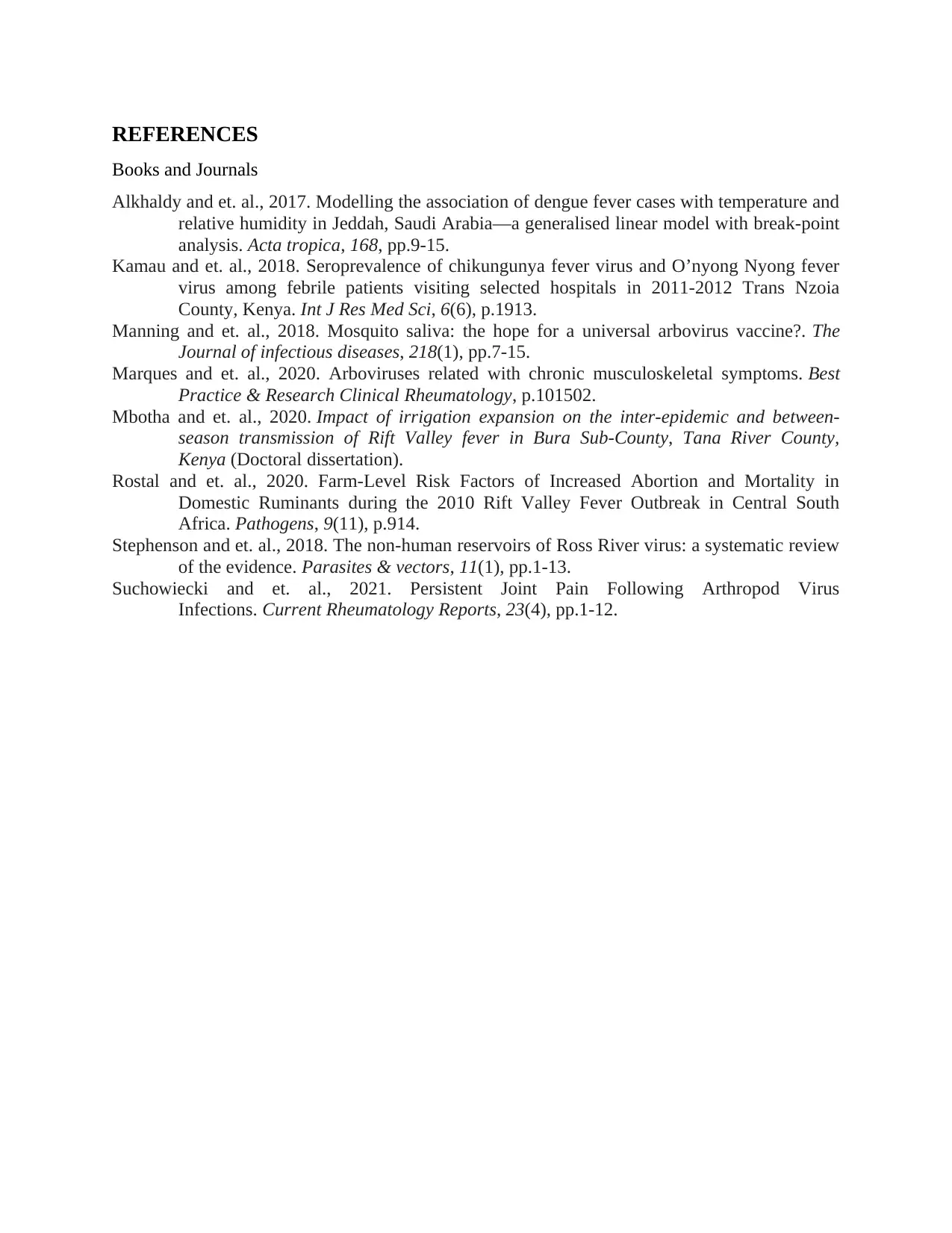
REFERENCES
Books and Journals
Alkhaldy and et. al., 2017. Modelling the association of dengue fever cases with temperature and
relative humidity in Jeddah, Saudi Arabia—a generalised linear model with break-point
analysis. Acta tropica, 168, pp.9-15.
Kamau and et. al., 2018. Seroprevalence of chikungunya fever virus and O’nyong Nyong fever
virus among febrile patients visiting selected hospitals in 2011-2012 Trans Nzoia
County, Kenya. Int J Res Med Sci, 6(6), p.1913.
Manning and et. al., 2018. Mosquito saliva: the hope for a universal arbovirus vaccine?. The
Journal of infectious diseases, 218(1), pp.7-15.
Marques and et. al., 2020. Arboviruses related with chronic musculoskeletal symptoms. Best
Practice & Research Clinical Rheumatology, p.101502.
Mbotha and et. al., 2020. Impact of irrigation expansion on the inter-epidemic and between-
season transmission of Rift Valley fever in Bura Sub-County, Tana River County,
Kenya (Doctoral dissertation).
Rostal and et. al., 2020. Farm-Level Risk Factors of Increased Abortion and Mortality in
Domestic Ruminants during the 2010 Rift Valley Fever Outbreak in Central South
Africa. Pathogens, 9(11), p.914.
Stephenson and et. al., 2018. The non-human reservoirs of Ross River virus: a systematic review
of the evidence. Parasites & vectors, 11(1), pp.1-13.
Suchowiecki and et. al., 2021. Persistent Joint Pain Following Arthropod Virus
Infections. Current Rheumatology Reports, 23(4), pp.1-12.
Books and Journals
Alkhaldy and et. al., 2017. Modelling the association of dengue fever cases with temperature and
relative humidity in Jeddah, Saudi Arabia—a generalised linear model with break-point
analysis. Acta tropica, 168, pp.9-15.
Kamau and et. al., 2018. Seroprevalence of chikungunya fever virus and O’nyong Nyong fever
virus among febrile patients visiting selected hospitals in 2011-2012 Trans Nzoia
County, Kenya. Int J Res Med Sci, 6(6), p.1913.
Manning and et. al., 2018. Mosquito saliva: the hope for a universal arbovirus vaccine?. The
Journal of infectious diseases, 218(1), pp.7-15.
Marques and et. al., 2020. Arboviruses related with chronic musculoskeletal symptoms. Best
Practice & Research Clinical Rheumatology, p.101502.
Mbotha and et. al., 2020. Impact of irrigation expansion on the inter-epidemic and between-
season transmission of Rift Valley fever in Bura Sub-County, Tana River County,
Kenya (Doctoral dissertation).
Rostal and et. al., 2020. Farm-Level Risk Factors of Increased Abortion and Mortality in
Domestic Ruminants during the 2010 Rift Valley Fever Outbreak in Central South
Africa. Pathogens, 9(11), p.914.
Stephenson and et. al., 2018. The non-human reservoirs of Ross River virus: a systematic review
of the evidence. Parasites & vectors, 11(1), pp.1-13.
Suchowiecki and et. al., 2021. Persistent Joint Pain Following Arthropod Virus
Infections. Current Rheumatology Reports, 23(4), pp.1-12.
1 out of 7
Related Documents
Your All-in-One AI-Powered Toolkit for Academic Success.
+13062052269
info@desklib.com
Available 24*7 on WhatsApp / Email
![[object Object]](/_next/static/media/star-bottom.7253800d.svg)
Unlock your academic potential
Copyright © 2020–2025 A2Z Services. All Rights Reserved. Developed and managed by ZUCOL.





